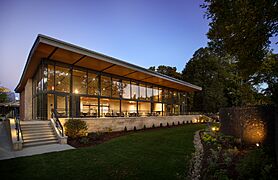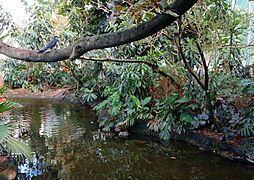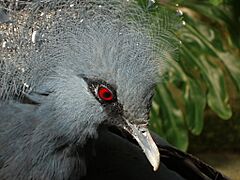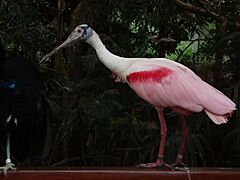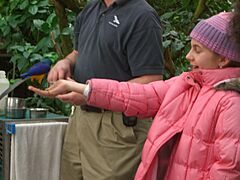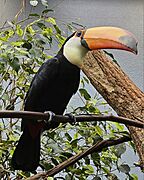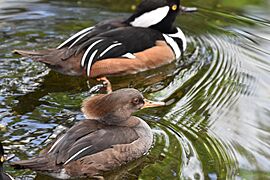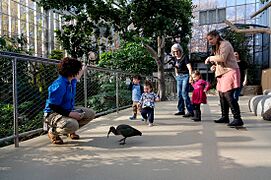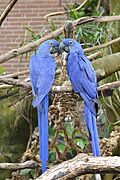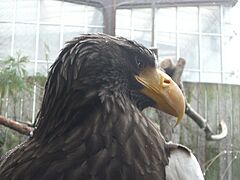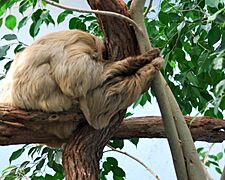National Aviary facts for kids
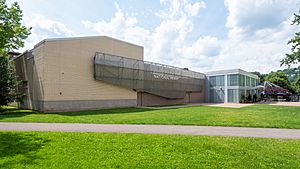
The National Aviary's Arch Street Entrance
|
|
| Date opened | Established in 1952; Went private in 1991; earned National designation in 1993 |
|---|---|
| Location | Allegheny Commons Park 700 Arch Street Pittsburgh, PA, 15212 United States |
| Coordinates | 40°27′12″N 80°00′36″W / 40.4533°N 80.01°W |
| No. of animals | 500+ |
| No. of species | 150+ |
| Annual visitors | 100,000+ |
| Memberships | Association of Zoos and Aquariums (AZA), Allegheny Regional Asset District (RAD) |
The National Aviary in Pittsburgh, Pennsylvania, is a special place for birds. It's the only independent indoor bird sanctuary in the United States. It's also the biggest indoor aviary in the country. The U.S. Congress even gave it the honorary "National" title.
This amazing place is home to over 500 birds. You can also see other animals and reptiles there. They represent more than 150 different kinds of species. The National Aviary has been a member of the Association of Zoos and Aquariums (AZA) since 1984. This means it meets high standards for animal care.
Contents
Exploring the National Aviary
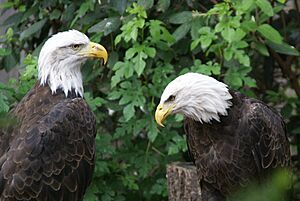
The National Aviary is located at 700 Arch Street. You can find it on Pittsburgh's Northside. It's inside Allegheny Commons Park.
Visitors can enjoy many fun activities every day. Some activities change with the seasons. You can watch African Penguins being fed at Penguin Point. This habitat lets you see them swim underwater. For an extra fee, you can even help feed the penguins. An Aviary expert will be there to guide you.
The Aviary also has daily feedings in its Tropical Rainforest and Wetlands areas. These are immersive habitats where you feel like you're right there with the birds. There are also expert talks and free-flight bird shows. Kids can enjoy interactive play spaces. All these activities make learning about birds exciting.
Amazing Birds and Animals
The Aviary cares for over 500 birds and other animals. They represent more than 150 species. Many of these species are threatened or endangered in the wild. This means they are at risk of disappearing forever.
Because of this, the Aviary has many rare species. You might not see them in other zoos. Examples include Andean condors. They also have the Critically Endangered Vietnam pheasant. This bird has not been seen in the wild since 2000.
Some popular residents are Sapphira and Jewel. They are colorful hyacinth macaws from the Tropical Rainforest. Another favorite is Wookiee, a Linnaeus's two-toed sloth.
Bird Conservation Efforts
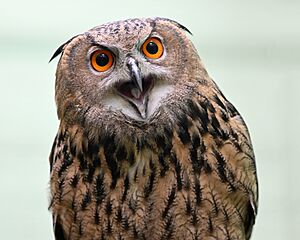
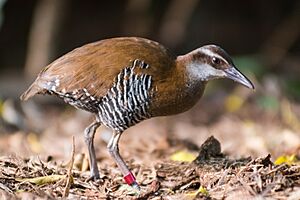
The National Aviary works hard to protect birds. They take part in Species Survival Plans (SSPs). These plans help save species that are in danger.
Some species they help include the Bali Myna. This bird is almost Extinct in the Wild. They also work with the Extinct in the Wild Guam kingfisher. The Vietnam Pheasant and the Critically Endangered African penguin are also part of these plans. SSPs help keep these animal populations healthy and growing.
The Aviary's first two African penguin chicks hatched in February 2012. Since then, they have welcomed over a dozen African Penguin chicks. This success led them to lead the Saving Animals From Extinction (SAFE) program for the African Penguin. This program helps wild African penguins facing many problems.
In March 2013, a female Eurasian owlet hatched. It doubled in size in just five days! The Aviary has since hatched over a dozen Eurasian Eagle-Owl chicks. They continue to expand their conservation work for this species.
The National Aviary not only helps species grow in numbers. They also work with partners to release these animals into the wild. This helps bring populations back to their natural homes.
In 2019, the Guam rail's status improved. It went from Extinct in the Wild to Critically Endangered. This was a huge success! It's only the second bird species ever to have its status improved like this. The California condor was the first. By 2020, the National Aviary had hatched more Guam Rails than any other zoo in North America.
Another species that might improve its status soon is the Guam kingfisher. In 2024, nine Guam kingfishers were released into the wild. This happened on Palmyra Atoll. Three of these birds hatched at the National Aviary. This was the first time a small group of this species lived in the wild since 1988. More releases are planned for 2025.
History of the Aviary
The National Aviary started in 1952. It was part of the Pittsburgh Aviary-Conservatory. The city built it on the site of an old conservatory. It began with one building. In 1967, it expanded to include a "wetlands room." In 1991, the city of Pittsburgh could no longer fund the Aviary.
Becoming a Private Organization
In 1991, local leaders formed Save the Aviary, Inc. They started a campaign to raise money. They also made a plan to make the Aviary a private organization. Jill Sims, a volunteer, became the first chairperson. Mark P. Masterson helped create a business plan. Save the Aviary, Inc. took over the facility.
Earning National Status
On October 27, 1993, the U.S. Congress gave the Pittsburgh Aviary a special honor. It was renamed the National Aviary in Pittsburgh. President Bill Clinton signed this into law on November 8, 1993.
In 1995, a project began to raise money for updates. These renovations were finished in 1997. They made the facility modern. In 2005, the Aviary started a new department. It focuses on conservation and field research. This department mainly helps restore bird populations in other countries.
In July 2006, Pennsylvania gave money for a big project. This project included a new education center. It also expanded exhibits. In October 2008, the Aviary announced a $23 million renovation. Most of this money came from private groups.
Recent Developments
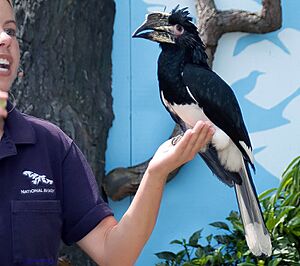

Cheryl Tracy has been the National Aviary's Executive Director since July 1, 2013. Under her leadership, the Aviary has completed several big projects. This includes the $17.5 million “Taking Flight” campaign. This campaign created the Penguin Point habitat. It is home to a group of Critically Endangered African Penguins.
In 2010, the Aviary finished an $18.5 million expansion. This project added a new café and classrooms. It also opened the Helen M. Schmidt FliteZone Theater. This is the first indoor theater in the U.S. built just for bird shows. The Aviary also started outdoor shows from its rooftop theater, SkyDeck. These shows feature birds of prey flying over Allegheny Commons Park.
The National Aviary opened The Garden Room in October 2020. This is a large venue for events and education.
On September 25, 2021, a Steller's sea eagle named Kodiak got out of his habitat. Many staff and volunteers worked together. Community members also reported sightings. Kodiak returned safely to the Aviary on October 3, 2021. In 2024, the Aviary welcomed a second Steller's Sea Eagle, a female from Estonia. Her name, Aurora, was chosen in a community contest. This contest raised over $14,000 for conservation.
In 2022, the Aviary finished renovating its largest habitat, the Wetlands. They installed new, energy-efficient glass. They also added new perches and plants.
Towards the end of 2024, the Aviary updated its Grasslands habitat. This area is home to small songbirds. These include red siskins and speckled mousebirds. The habitat got new skylights and more greenery.
In January 2025, the National Aviary announced a new partnership. They are working with the SK Rockwell Conservancy. They plan to build a world-class bird care center. This center will help breed endangered species. It will also have a modern veterinary hospital. The Aviary also welcomed new mammal and reptile species in early 2025.
Gallery
-
A close-up of a Victoria crowned pigeon.
-
A girl feeds worms to a golden-breasted starling.
-
A toco toucan.
-
Two hyacinth macaws.
-
A sloth in a tree in the aviary.


